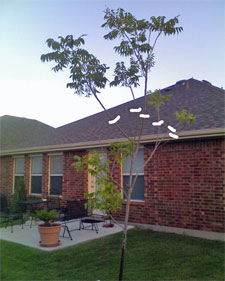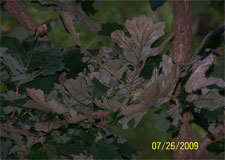Question and answer – September 2009
NOTE FROM NEIL
Before I get into this month’s questions, please let me reemphasize: this is a visual medium. Our one ground rule is that your question must be accompanied by a photo. If you don’t have a photo, feel free to call one of my radio programs or to write to my Q&A newspaper and GARDENS magazine columns.
We get more than 150 e-mails per issue of e-gardens alone. With great apologies, I cannot reply to those questions that do not have photos attached. Of the 10 to 15 percent of questions that are accompanied by photos, we are able to use most in e-gardens. However, we do select those of greatest general reader interest.
I apologize to all who write without photos, as well as those who write the same question someone else has written. I spend many hours editing and preparing this column and the Q&A section of our magazine. I wish I could do more, but there just isn’t time.
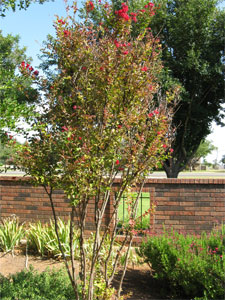
Question: Our Red Rocket crape myrtle was damaged by a late freeze. Now, it has rose/lime-colored leaves and few blooms. What is the problem? G.K., Seymour.
Answer: My guess would be that you hit it on the head with your reference to the late freeze. This is the same way that crape myrtles look when they’ve been exposed to really low temperatures in mid-winter. The leaves become sparse and off-colored. If you see new shoots coming up around the base of the plant, leave them in place. They may make better trunks eventually than these will. I have cut many crape myrtles back to the ground to get rid of freeze damage, but I’d probably see how this one looks come spring.
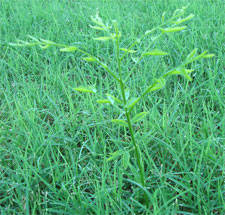
Question: I had to remove a soapberry tree last fall. Do you think these are coming up from its old roots? S.S., Rockwall.
Answer: That would be my guess. But, you can easily tell simply by digging one of them up. If it’s tethered to a piece of old root, you’re correct. If it sprouted from a seed, it’s a free-standing seedling. Best way to remove them would probably be just to mow them down periodically. Either as sprouts or seedlings, they won’t tolerate that treatment very long. If you want to leave one of them to regrow, simply put a stake alongside it to protect it until it’s 18 to 24 inches tall.
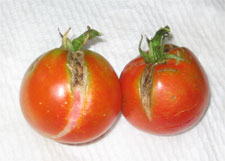
Question: I’m growing a garden in my backyard for the second time. Everything started growing well in the spring, but then I bought some cheap compost with chicken manure from one of the national chains. Since I added it, everything has gone downhill. The photo is of my garden as it looks today. 10 or 12 weeks ago, the tomatoes were as big as softballs. Now, they’re cherry-sized. I try to water every day, but I sometimes miss a day. Please help. J., no city given.
Answer: This is absolutely caused by exposure to hot weather. To keep my answer brief, I’m going to cut right to the chase: we in Texas should never grow huge-fruiting tomatoes. They are not adapted in any way to our summer temperatures. So, that’s the first strike. Second strike: Spring tomato plants almost never make it through the hot July and August weather intact. We must plant new, vigorous transplants the last week of June or by very early July. They, too, should be of the small or medium-sized varieties. Third strike, and your tomatoes are out: this is cracking caused by big swings in temperatures, especially toward "hot." Just as windshields crack when dings warm up rapidly, so will tomatoes. Harvest them as they start to ripen, and let them finish the job indoors on a towel or newspaper. Focus on changes for next spring, and you’ll have far better results.

Question: The photo shows our struggling garden. We brought the soil in from a local compost company. We planted seeds and transplants in late March, but not much happened after that. Suggestions? D.K., Fort Worth.
Answer: Ouch! You had fresh, undecomposed organic matter in the soil, and the bacteria that got active breaking down the organic matter tied up the available nitrogen. Your recourse at this point: rototill several times over the next several months. Fertilize the bare soil with an all-nitrogen lawn food (no weedkiller) to "feed" the bacteria and speed up the decay process. Work several inches of other types of organic matter into the soil. I’d use Canadian peat, pine bark mulch and well-rotted compost and leaf mold from my own landscape. In Texas, you can grind up almost anything and call it compost. True compost has decayed to the point that you can no longer recognize its components. It will be moist, and it will have a rich, earthy smell. It’s not uncommon to find “compost” containing ground-up bits of lumber, chunks of tree branches and other organic matter that just isn’t ready for use in the ground. As a mulch on top of the ground, maybe. As a soil-amending compost, probably not.
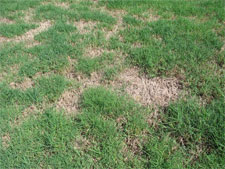
Question: What is causing these brown patches in my bermudagrass lawn? I am getting some non-grassy weeds moving in as well. P., Haslet.
Answer: It looks like cottony blight. That’s a water mold fungus that hits bermuda and does serious damage during the summer. I would suggest you get confirmation from the Plant Disease Diagnostic Laboratory at Texas A&M. Your county Extension office will have the materials and information for mailing. You may end up using a labeled fungicide. You’ll have to wait for these patches to grow back in from the sides. This disease does kill bermuda. You might consider taking some 4-inch-wide plugs from healthy grass and planting it into these areas. The lawn looks odd anyway, and that might speed its recovery. Do get it tested, however, and follow their recommendations for your fungicide. The weed that’s invading appears to be vetch (a broadleafed weed). Use a broadleafed herbicide containing 2,4-D to control it. Read and follow label directions carefully.
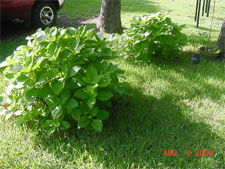
Question: Why don’t my hydrangeas bloom? They’re four years old, and they had flowers when I bought them. They’re in good black soil that drains well. They’re beneath oak trees, so they get diffused light, mostly shade. J., between Mabank and Canton.
Answer: When I read your question and prepared to open the photo file, I was expecting to see iron-deficient, yellowed and struggling plants. When someone refers to "black soil," that’s usually what I see. However, your plants look terrific. My thoughts would be that they may be getting too much nitrogen by growing in proximity to your lawn. Their growth looks very vigorous. Did you trim them last winter? If so, don’t do that again, because hydrangeas produce their floral bracts on growth made the previous year. Do any pruning you must immediately after they flower (or would normally flower – late spring), then try to do no more for a year. Lighting is a tricky thing. In the photo, the shading does not appear excessive for hydrangeas, so long as it looks this way most of the day. Failure to bloom can often be traced to having plants in total shade. Scorching and burning occur because plants are in full or nearly full sun. You need to hit the middle.
Question: This is my father-in-law’s pecan tree. How much can it safely be trimmed back come winter? R., Celina.
Answer: His tree does appear a bit lanky. In training young fruit and nut trees, we do have to do some unusual and creative pruning to direct their initial limb growth and development. There are two groups of three limbs each, and each of those six branches probably needs to be cut back by half the distance to the main trunk. Select your pruning sites just above buds that face out away from the center of the tree. Your goal is to get a fuller, more rounded specimen, and this should be a one-time type of pruning. I have attempted to give you general guidelines by marking your photo. Follow the trimming with an all-nitrogen fertilizer, 1 pound per inch of trunk diameter, monthly March through May.

Question: I planted this magnolia two years ago. This spring, it produced many flowers, but it dropped many leaves. Now, the leaves seem to be coming back. Is this normal? I’m impatient. C.K., Lake Kiowa.
Answer: I don’t blame you for being impatient. You bought a handsome tree, and now it’s failing. In all honesty, were this my tree, I’d consider cutting it back similar to what I just recommended for the pecan above. However, in this case, the pruning would be to compensate for the massive leaf drop and lankiness that probably is the result of your tree having gotten too dry at least one time. Apply an all-nitrogen fertilizer to prompt good regrowth.
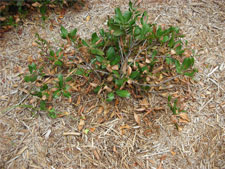
Question: Something is killing all of my Indian hawthorns. The soil drains well, and I have sprayed with an insecticide and a fungicide. I have taken very good care of them. Last year, two plants were affected. Now, all of them are. C.C., Burleson.
Answer: There are two possibilities. I have my suspicions, but let me list the options first. Hawthorns are susceptible to Entomosporium fungal leaf spot (the same disease that has done so much damage to redtip photinias). On hawthorns, it shows up first as small, maroon freckles all over the leaves. The plants gradually thin and die, and it spreads through the bed. Fungicides have not proven effective on it, so that news is not good. Second, hawthorns that are in full sun may develop scorched, tan blotches on their leaves, most especially if the exposure to sun is accompanied with letting the plants get too dry at least one time. Honestly, that’s what this looks like. Hopefully, you have them growing in loose, highly organic and moist soil. It’s best to add several inches of Canadian peat, pine bark mulch and rotted compost prior to planting.
Question: I have an oak tree with leaves that are becoming colorless. Is it dying? What can be done to stop it? A.J., Como.
Answer: We had several questions like yours, and this damage is done by larvae of sawflies. Systemic insecticidal sprays would have helped in the spring or early summer, but there is no call to action for now. It’s much more cosmetic than it is threatening. Really makes the trees look ratty, though, doesn’t it!?
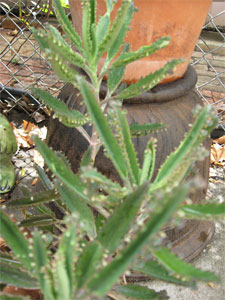
Question: I am involved with a Junior Master Gardeners club at my school. Someone gave us this plant to sell, but we’ve been told by various people that it’s both highly invasive and poisonous. I believe it’s Bryophyllum daigremontianum. Should we dump it? J.W., Fort Worth.
Answer: You have the plant identified correctly. Go to the amazing website www.bryophyllum.com. The plant is also called "mother of thousands" because of its ability to produce plantlets along the notches in its leaves. That’s why it would be described as invasive, but I can tell you that bermudagrass is ten thousand times more invasive than this little tropical succulent from the jade plant and kalanchoe family ever dreamed of being. I’ve grown this plant and a couple of its sisters for probably 40 years, and this is the first time anyone has mentioned that it is poisonous. I’d be amazed if it ever caused any problem. Then again, some of the other plants that are poisonous include morning glories, oak acorns, tomato leaves, azaleas, Carolina jessamine, tulips and daffodils and the old standards, oleanders and castor beans. Of that batch, the only one I would not want in my yard if I had children around would be castor beans, as its level of toxicity is very high. Having poisonous plants around us is about like having electricity, gasoline, bleach and swimming pools – we have to teach young children as soon as they’re old enough to walk. What you do with this plant is certainly your own business, but it wouldn’t concern me a bit to share it with another gardener.

